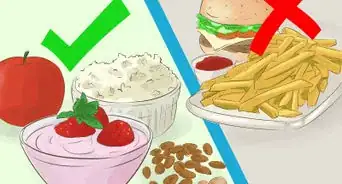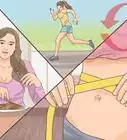This article was co-authored by Patricia Somers, RD, PhD. Patricia Somers is a Registered Dietitian and an Associate Professor of the Department of Educational Leadership and Policy at the University of Texas at Austin. She received her RD from the Academy of Nutrition and Dietetics in 1979 and her PhD in Educational Administration (Higher Education Specialization) from the University of New Orleans. She received an Emerging Scholar Award from the American Association of University Women and the Faculty Excellence Award in Research from the University of Arkansas, Little Rock.
This article has been viewed 245,583 times.
The Copenhagen diet, also known as the 13-Day or Royal Danish Hospital Diet is a strict and severe short-term diet. Proponents of the diet claim you can lose 13 – 22 lbs in just 13 days. This is not a healthy way to lose weight and keep it off in the long-term. Most of the weight you will lose if you complete this diet will come from lost water, not lost fat. It also instructs you to consume large amounts of cholesterol and protein-rich food which can damage your health. It causes such a shock to your metabolism that you should never complete the diet more than once every two years. Note that it also has no connection to the Royal Danish Hospital.[1] To lose weight healthily, change to a balanced diet and take regular exercise. Speak to your doctor before trying any radical diets.
Steps
Completing the First Week
-
1Drink two litres of water everyday. The diet gives your metabolism a major shock, and you should consider carefully whether this is a good choice. If you do go ahead with it you need to make sure you consume a lot of water. It is recommended that you try to drink two litres of water a day during this diet.
-
2Follow the guide for day one and two. If you do decide to complete this diet, its proponents claim you have to stick to it very closely. It features a dramatic drop of in calories, which may leave you feeling weak and fatigued. On day one you are instructed to have just a coffee with one teaspoon of sugar for breakfast. Lunch is two hard boiled eggs together with 400 grams (14 oz) of boiled spinach and a tomato. Dinner is 200 grams (7.1 oz) of beef served with 150 g (2 cups) of lettuce drizzled with lemon juice and a little olive oil.
- On day two you are again instructed to skip breakfast, just drinking a cup of coffee with one sugar like the previous day.
- For lunch the diet requires 250 grams (8.8 oz) of ham and one serving of fat-free yoghurt.
- The dinner is the same as day one: 200 grams (7.1 oz) of beef, with 150 g (2 cups) of lettuce as a side. You can add a little oil or lemon juice to dress the lettuce.
- This diet provides around 600 calories/day and will lead to malnutrition. You can not get all of the nutrients you need on 600 cal/day. Your metabolism will shift; your body will think you are starving.
- It is recommended that if you are consuming under 800 cal/day you should be supervised by a medical professional. If you begin to feel overly tired or weary from the sudden drop in calories consider whether or not to continue.
Advertisement -
3Tackle days three and four. On the third day you will again be consuming very few calories. You can add one piece of toast to your breakfast coffee. For lunch you are combining elements from previous days, eating two hard boiled eggs, 100 grams (3.5 oz) of lean ham and 150 g (2 cups) of lettuce. In the evening you are instructed to eat just one tomato, some boiled celery, and one portion of fruit. This could be, for example, an apple, orange or pear.
- On the fourth day you stick with the minimal breakfast of coffee and one slice of bread.
- Lunch is just one serving of fat-free yoghurt coupled with a 200 milliliters (6.8 fl oz) glass of orange juice.
- For dinner the diet requires you eat one hard boiled egg, along with one carrot, and a single serving of cottage cheese.
-
4Move on to days five and six. Day five begins with the same austere breakfast of coffee and one slice of bread. It is followed by 150–200 grams (5.3–7.1 oz) of boiled fish, such as salmon. For dinner on day five you are instructed to eat 250 grams (8.8 oz) of beef with celery as a side.
- Keep to the same breakfast of coffee and one slice of bread on day six.
- Follow this with two hard boiled eggs and one carrot for lunch.
- Dinner on day six should be 300 grams (11 oz) of boiled skinless chicken breast, alongside 150 g (2 cups) of lettuce as a side.
Finishing the Second Week
-
1Continue with days seven and eight. You are now a week into the diet and will probably be tired and hungry. Day seven starts with no breakfast, just a cup of tea without sugar. It gets worse with no lunch, just lots and lots of water. You do get to eat something in the evening, but only 200 grams (7.1 oz) of lamb and one apple.
- Day eight is a little easier, but you still go without breakfast and only drink a coffee with one sugar.
- Day eight is the same as day one: two hard boiled eggs with 400 grams (14 oz) of boiled spinach and a tomato for lunch.
- In the evening you can eat 200 grams (7.1 oz) of beef with 150 g (2 cups) of lettuce. You can add a little lemon juice and olive oil to the lettuce for extra flavour.
-
2Keep going for days nine and 10. On day nine you continue to skip breakfast, just drinking a coffee with one sugar. At lunch time you are permitted to eat 250 grams (8.8 oz) of lean ham along with one pot of natural yoghurt. For dinner you can eat a little more than the previous evening: 250 grams (8.8 oz) of beef with 150 g (2 cups) of lettuce.
- On day 10 you have one slice of bread with your coffee for breakfast, the first solid breakfast since day six.
- Lunch is two hard boiled eggs together with 100 grams (3.5 oz) of ham and some lettuce on the side.
- The food for the evening the same as day three, just one tomato, some boiled celery and one serving of fruit.
-
3Push on to days 11 and 12. The end is almost in sight, and you will no doubt be feeling the strains of such a severely restrictive diet. On day 11 stick with a coffee and one slice of bread for breakfast. For lunch eat one pot of natural yoghurt and drink 200 milliliters (6.8 fl oz) of orange juice. Day 11 is the same as day four and for dinner you again eat one hard boiled egg, one carrot and one serving of cottage cheese.
- On day 12, have just one carrot for breakfast, before eating 200 grams (7.1 oz) of boiled fish for lunch. You can add a little butter and lemon juice to the fish.
- For your dinner eat 250 grams (8.8 oz) of beef with some celery on the side.
-
4Finish on day 13. On the final day start with the familiar breakfast of one cup of coffee with a slice of toast. For lunch you can eat two hard boiled eggs along with one carrot. On the last day the diet advises you to skip the evening meal altogether.
Maintaining Your Health and Wellbeing During the Diet
-
1Monitor yourself during the diet. The Copenhagen Diet involves a dramatic drop in the nutrients as well as the calories you consume and that are essential to your health. It also involves skipping meals on many days, which can be very dangerous and damage your overall health. If you do undertake this diet it is important to closely monitor how you feel.
- People undertaking an extremely restrictive, low-calorie diet should be monitored by their doctor throughout the process.
- If you begin to feel especially lethargic or light-headed, then you should re-consider completing the diet and opt for a more balanced approach.
- There is little available medical advice for those using this diet, most likely because no health professional would recommend you to do it.
-
2Be wary of exercise. The severity of diet means that it is unlikely that you will have the energy required for even moderate exercise during the two weeks. It's important to try to keep up some physical activity but don't push yourself while on the diet. Gentle exercise such as walking or stretching can be one way to keep up some activity.
- The fact that you will probably not be able to exercise during the diet highlights how extreme it is, and it's short-term nature.
- Doing a diet that involves exercise instead will help to maintain lean muscle mass while you burn fat.[2]
-
3Understand this is not a long-term solution. The nature of this diet means that most of the weight you lose will be water weight, rather than fat. As a result, you can find that you rapidly re-gain the weight lost during the course of the diet once you start eating normally again. This can be a very demoralizing experience but it does reflect the short-term nature of severe diets such as the Copenhagen Diet.
- Understanding that this is a short-term option will help you understand the changes to your body that you experience.
- You can use the diet to kick start a new healthier lifestyle.
- The self-control and discipline you learn sticking to the diet could help you push on to more healthy lifestyle.
- Quickly losing then gaining weight is known as "yo-yo dieting" and has been linked to a higher risk of sudden cardiac death and coronary heart disease death for women.[3]
-
4Set the right goals. The Copenhagen Diet is not an answer to an unhealthy lifestyle and nor is it a path to a healthy one. You can experience quick weight loss over the two weeks but this should be coupled with positive goals for long-term health. Try not to focus exclusively on pounds shed, but changes that will lead to sustained benefits.[4] The Copenhagen Diet should only ever be one part of your broader goals.
- You can start by undertaking the diet, but have goals for a longer period than the two weeks of dieting.
- Be specific and realistic with your goals. You want to be able to measure your progress and not set yourself an impossible task which will only act to demotivate you when you struggle to attain it.[5]
Expert Q&A
-
QuestionCan I have only one coffee per day?
 Patricia Somers, RD, PhDPatricia Somers is a Registered Dietitian and an Associate Professor of the Department of Educational Leadership and Policy at the University of Texas at Austin. She received her RD from the Academy of Nutrition and Dietetics in 1979 and her PhD in Educational Administration (Higher Education Specialization) from the University of New Orleans. She received an Emerging Scholar Award from the American Association of University Women and the Faculty Excellence Award in Research from the University of Arkansas, Little Rock.
Patricia Somers, RD, PhDPatricia Somers is a Registered Dietitian and an Associate Professor of the Department of Educational Leadership and Policy at the University of Texas at Austin. She received her RD from the Academy of Nutrition and Dietetics in 1979 and her PhD in Educational Administration (Higher Education Specialization) from the University of New Orleans. She received an Emerging Scholar Award from the American Association of University Women and the Faculty Excellence Award in Research from the University of Arkansas, Little Rock.
Registered Dietitian There is no official guide for the Copenhagen Diet, but I would say that you could have more than one coffee/day, as long as it is black. Black coffee will not add any calories.
There is no official guide for the Copenhagen Diet, but I would say that you could have more than one coffee/day, as long as it is black. Black coffee will not add any calories. -
QuestionThe Copenhagen diet only works for the short-term and you will very likely regain the weight when it's over. Is this a correct assumption since the this plan does not follow the principle that people need to eat various kinds of food?
 Patricia Somers, RD, PhDPatricia Somers is a Registered Dietitian and an Associate Professor of the Department of Educational Leadership and Policy at the University of Texas at Austin. She received her RD from the Academy of Nutrition and Dietetics in 1979 and her PhD in Educational Administration (Higher Education Specialization) from the University of New Orleans. She received an Emerging Scholar Award from the American Association of University Women and the Faculty Excellence Award in Research from the University of Arkansas, Little Rock.
Patricia Somers, RD, PhDPatricia Somers is a Registered Dietitian and an Associate Professor of the Department of Educational Leadership and Policy at the University of Texas at Austin. She received her RD from the Academy of Nutrition and Dietetics in 1979 and her PhD in Educational Administration (Higher Education Specialization) from the University of New Orleans. She received an Emerging Scholar Award from the American Association of University Women and the Faculty Excellence Award in Research from the University of Arkansas, Little Rock.
Registered Dietitian You are absolutely right! This diet is short-term, and does not meet the nutritional needs of an individual. Develop good, lasting eating habits and exercise to lose weight in a healthy, sustainable way.
You are absolutely right! This diet is short-term, and does not meet the nutritional needs of an individual. Develop good, lasting eating habits and exercise to lose weight in a healthy, sustainable way.
Warnings
- This diet could do more harm than good.⧼thumbs_response⧽
- Possible side effects: Irritability, severe weakness of the body, fainting, hair loss, problems with nails and complexion — all due to malnutrition.⧼thumbs_response⧽
- Consult a doctor about a more balanced weight loss programme.⧼thumbs_response⧽
- This might cause malnutrition.⧼thumbs_response⧽
References
- ↑ http://www.dietsinreview.com/diets/royal-danish-hospital-diet/
- ↑ http://ajcn.nutrition.org/content/89/4/1043.full
- ↑ http://newsroom.heart.org/news/Xyo-yo-dieting-dangerous-even-if-youre-not-overweight
- ↑ https://www.nhlbi.nih.gov/health/educational/lose_wt/behavior.htm
- ↑ https://www.nhlbi.nih.gov/health/educational/lose_wt/behavior.htm
About This Article
To use the Copenhagen diet, you'll need to drink 2 litres of water every day and follow a strict eating schedule for 13 days. Keep in mind that the Copenhagen diet is not a healthy way to lose weight, and you should only try it once every 2 years due to the shock it gives to your metabolism. If you go ahead, monitor how you feel during the 13 days of the diet and stop immediately if you feel lightheaded or lethargic. Additionally, avoid exercise because you won't be getting enough calories to generate the energy you'll need. You should also set health goals beyond the 2-week diet so you can change your lifestyle in a sustainable way. To learn what you're allowed to eat on each day of the diet, keep reading!






































































Medical Disclaimer
The content of this article is not intended to be a substitute for professional medical advice, examination, diagnosis, or treatment. You should always contact your doctor or other qualified healthcare professional before starting, changing, or stopping any kind of health treatment.
Read More...